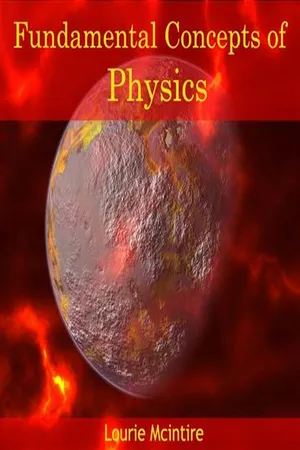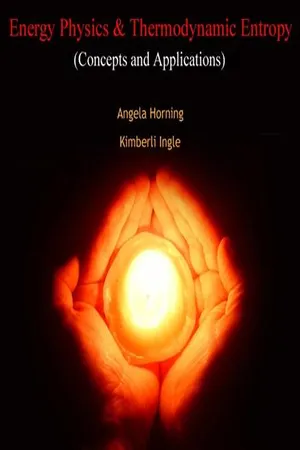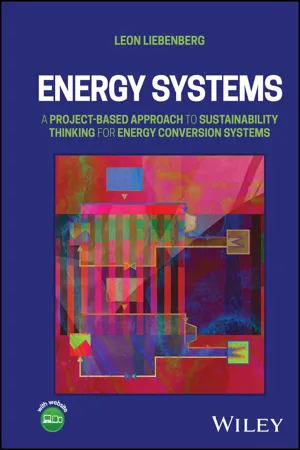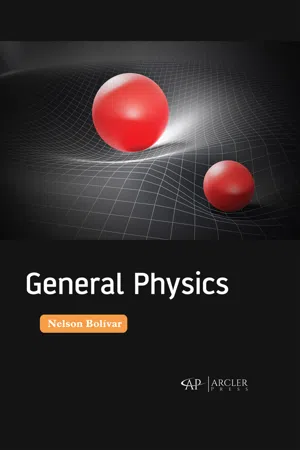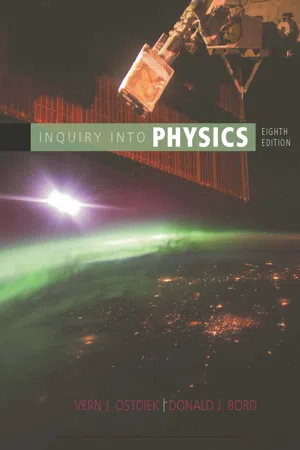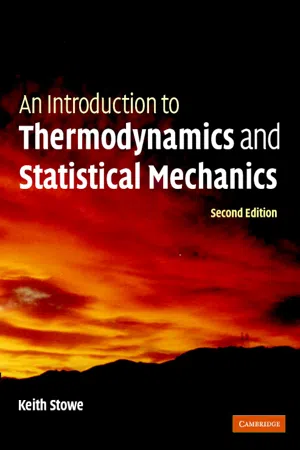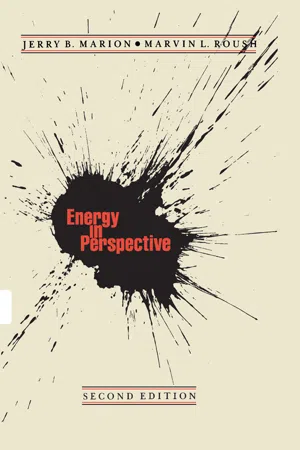Physics
Energy Physics
Energy physics is the branch of physics that focuses on the study of energy and its various forms, including potential energy, kinetic energy, and thermal energy. It explores the principles governing the transformation of energy from one form to another and its impact on the behavior of physical systems. Understanding energy physics is crucial for comprehending the fundamental processes underlying natural phenomena and technological advancements.
Written by Perlego with AI-assistance
Related key terms
1 of 5
10 Key excerpts on "Energy Physics"
- No longer available |Learn more
- (Author)
- 2014(Publication Date)
- White Word Publications(Publisher)
In particle physics, this inequality permits a qualitative understanding of virtual particles which carry momentum, exchange by which and with real particles, is responsible for the creation of all known fundamental forces (more accurately known as fundamental interactions). Virtual photons (which are simply lowest quantum mechanical energy state of photons) are also responsible for electrostatic interaction between electric charges (which results in Coulomb law), for spontaneous radiative decay of exited atomic and nuclear states, for the Casimir force, for van der Waals bond forces and some other observable phenomena. Applications of the concept of energy Energy is subject to a strict global conservation law; that is, whenever one measures (or calculates) the total energy of a system of particles whose interactions do not depend explicitly on time, it is found that the total energy of the system always remains constant. • The total energy of a system can be subdivided and classified in various ways. For example, it is sometimes convenient to distinguish potential energy (which is a function of coordinates only) from kinetic energy (which is a function of coordinate time derivatives only). It may also be convenient to distinguish gravitational energy, electric energy, thermal energy, and other forms. These classifications overlap; for instance, thermal energy usually consists partly of kinetic and partly of potential energy. • The transfer of energy can take various forms; familiar examples include work, heat flow, and advection, as discussed below. ________________________ WORLD TECHNOLOGIES ________________________ • The word energy is also used outside of physics in many ways, which can lead to ambiguity and inconsistency. The vernacular terminology is not consistent with technical terminology. - No longer available |Learn more
- (Author)
- 2014(Publication Date)
- Learning Press(Publisher)
• The total energy of a system can be subdivided and classified in various ways. For example, it is sometimes convenient to distinguish potential energy (which is a function of coordinates only) from kinetic energy (which is a function of coordinate time derivatives only). It may also be convenient to distinguish gra-vitational energy, electric energy, thermal energy, and other forms. These classi-fications overlap; for instance, thermal energy usually consists partly of kinetic and partly of potential energy. • The transfer of energy can take various forms; familiar examples include work, heat flow, and advection, as discussed below. • The word energy is also used outside of physics in many ways, which can lead to ambiguity and inconsistency. The vernacular terminology is not consistent with technical terminology. For example, while energy is always conserved (in the sense that the total energy does not change despite energy transformations), energy can be converted into a form, e.g., thermal energy, that cannot be utilized to perform work. When one talks about conserving energy by driving less, one talks about conserving fossil fuels and preventing useful energy from being lost as heat. This usage of conserve differs from that of the law of conservation of energy. In classical physics energy is considered a scalar quantity, the canonical conjugate to time. In special relativity energy is also a scalar (although not a Lorentz scalar but a time component of the energy-momentum 4-vector). In other words, energy is invariant with respect to rotations of space, but not invariant with respect to rotations of space-time (= boosts). Energy transfer Because energy is strictly conserved and is also locally conserved (wherever it can be defined), it is important to remember that by the definition of energy the transfer of energy between the system and adjacent regions is work. A familiar example is mechanical work . In simple cases this is written as the following equation: - No longer available |Learn more
- (Author)
- 2014(Publication Date)
- Academic Studio(Publisher)
• The total energy of a system can be subdivided and classified in various ways. For example, it is sometimes convenient to distinguish potential energy (which is a function of coordinates only) from kinetic energy (which is a function of coordinate time derivatives only). It may also be convenient to distinguish gravitational energy, electric energy, thermal energy, and other forms. These classifications overlap; for instance, thermal energy usually consists partly of kinetic and partly of potential energy. • The transfer of energy can take various forms; familiar examples include work, heat flow, and advection, as discussed below. • The word energy is also used outside of physics in many ways, which can lead to ambiguity and inconsistency. The vernacular terminology is not consistent with technical terminology. For example, while energy is always conserved (in the sense that the total energy does not change despite energy transformations), energy can be converted into a form, e.g., thermal energy, that cannot be utilized to perform work. When one talks about conserving energy by driving less, one talks about conserving fossil fuels and preventing useful energy from being lost as heat. This usage of conserve differs from that of the law of conservation of energy. In classical physics energy is considered a scalar quantity, the canonical conjugate to time. In special relativity energy is also a scalar (although not a Lorentz scalar but a time component of the energy-momentum 4-vector). In other words, energy is invariant with respect to rotations of space, but not invariant with respect to rotations of space-time (= boosts). ______________________________ WORLD TECHNOLOGIES ______________________________ Energy transfer Because energy is strictly conserved and is also locally conserved (wherever it can be defined), it is important to remember that by the definition of energy the transfer of energy between the system and adjacent regions is work. - eBook - PDF
- Richard L. Myers(Author)
- 2005(Publication Date)
- Greenwood(Publisher)
Since the universe con- sists of a system and the surroundings, the conservation of energy means that the energy of a system and its surroundings will be constant. While it is impossible to measure the amount of energy the universe contains, changes in the energy stored in a system may be examined. Energy can be stored in a sys- tem as potential, kinetic, and internal energy. Furthermore, energy can be transferred across the system's boundary as work. Another form in which energy can be transferred across a system's boundary is as heat. The transference of energy as work and heat results in changes in the energy stored within the system. While other forms of energy transfer can take place through mass transfer (such as evaporation out of an open jar), sound, nuclear radiation, and light, these will be minor in many situa- tions and will not be considered. By examin- ing the energy stored in a system and energy transference by work and heat, several funda- mental principles relating energy, work, and heat can be derived as special cases of the conservation of energy law. When a force is applied on an object (it will be assumed that the object itself com- prises the system) causing movement, work has been done on the object. The force causes the object to accelerate according to Newton's second law: F - ma. The acceleration of the object can be written as (v f - v.)/At, so F equals m(v f - v.)/At. The work done on the object is Fd. The magnitude of the displace- ment, d, is equal to the average velocity times the time interval (v f + v.)At/2. Multiplying the equations for force and displacement gives an 2 expression relating work and kinetic energy: This statement is one form of the work- energy theorem. It states that when a net force performs work on an object, and this work results only in changing the kinetic energy of the object, that the work equals the change in kinetic energy of the object. In this situation - John Reisel(Author)
- 2021(Publication Date)
- Cengage Learning EMEA(Publisher)
35 C H A P T E R 2 The Nature of Energy Learning Objectives Upon completion of Chapter 2, you will be able to 2.1 Explain the nature of energy and the different forms that energy can take; 2.2 Identify the methods of transporting energy into or out of a system; 2.3 Recognize the three modes of heat transfer; 2.4 Describe and compute the many modes of work; and 2.5 Express an approach and framework for solving thermodynamic problems. 2.1 WHAT IS ENERGY? Energy is something that most people inherently understand, but it is very hard to define. The Oxford English Dictionary defines energy as the “ability or capacity to produce an effect.” Considering this definition, a substance or object with energy has the ability to change itself or its surroundings. For example, a substance with energy can move, or it can do work, or it can heat some other substance. Energy is a property of a substance. The quantity of energy that a substance has is not related to how the state of the substance was reached, but rather is only a function of the local thermodynamic equilibrium state. In this chapter, we will describe some of these concepts in more detail. Energy is also of great interest in the world today. Modern society has developed because of the ability of humans to harness the energy in the world around us. The use of energy surrounds us every day. Energy is used to heat or cool buildings. Energy is used by vehicles to transport people and goods. Energy is used in computers, lights, and every electrical device in our homes and offices. Energy is used to manufacture everything we see around us. As a result, the supply and cost of energy is often paramount in our minds. Many engineers deal with energy on an everyday basis. Some engineers work on producing electricity or transportation fuels. Some engineers seek new ways to harness nature’s energy. Other engineers try to make devices more efficient users of energy so that the energy that is available can last longer.- eBook - PDF
Energy Systems
A Project-Based Approach to Sustainability Thinking for Energy Conversion Systems
- Leon Liebenberg(Author)
- 2024(Publication Date)
- Wiley(Publisher)
(2019) and Paoli and Cullen (2020). 6 1 Introduction to Energy It is useful to classify the forms of energy into either microscopic or macroscopic forms of energy. Microscopic forms of energy are related to the energy contained in molecules due to the movement of molecules or due to intermolecular forces – these are characterized by evaluating the internal energy of a system. Macroscopic forms of energy are related to the gross characteristics of a substance on a large scale, compared to the mean free path of the molecules – these are characterized by evaluating the kinetic energy and potential energy of a system. The total energy (E) is a property of a system and may be defined as the sum of all microscopic and macroscopic forms of energy (Black and Hartley 1985): E = E microcopic + E macroscopic J 1 2 When one analyzes conventional energy conversion systems, it will be rare to contend with both microscopic and macroscopic forms of energy. For instance, when one is dealing with nuclear power, photovoltaics, or fuel combustion, the focus will be on the microscopic characteristics (inter- nal energy). When one is dealing with wind or hydro power, the focus will be on the macroscopic aspects (kinetic energy or potential energy). Kinetic energy and potential energy are often also called mechanical energy. Mechanical energy is a form of energy that can be completely converted to work. With all energy conversion systems, we are interested in the transfer of heat (Q) and work (W), so we will also define these terms. It is important to acknowledge that energy can also be transferred by mass (m) or mass flow rate m . - eBook - PDF
- Nelson Bolívar(Author)
- 2020(Publication Date)
- Arcler Press(Publisher)
The rotation of the earth on its axis in space is perhaps an extreme example of such a General Physics 130 machine. However, due to interactions with the moon, tidal friction, and other heavenly bodies, it too is increasingly slowing. Every couple of years, scientists need to add a leap second to our record of time to interpretation for the difference in the length of the day. 5.8. THERMAL ENERGY The energy contained within a system that is responsible for its temperature known as Thermal energy . The Flow of thermal energy is called heat. A whole branch of thermodynamics , physics, deals with how heat is transferred among dissimilar systems and how work is done in the process (Hughes, 2012). From the perspective of mechanics problems, we are generally involved in the role thermal energy plays in guaranteeing the conservation of energy. Nearly every transfer of energy that takes place in real-world physical systems does so with competence lower than 100% and results in some thermal energy. This energy is typically in the form of low-level thermal energy. Now, low-level indicates that the temperature-related with thermal energy is near to that of the environment (Fishbone and Abilock, 1981). It is only probable to excerpt work when there is a temperature difference, thus low-level thermal energy signifies ‘the end of the road’ of energy transfer. No additional useful work is possible; the energy is currently ‘lost to the environment.’ 5.8.1. Thermal Energy from Friction Imagine a man pushing a box through a rough floor at a constant velocity as shown in Figure 5.8. Because the friction force is non-conservative, the work done as potential energy is not stored. T he work is done by the friction force outcomes in the transmission of energy into the thermal energy of the box-floor system. This thermal energy moves as heat inside the floor and box, finally raising the temperature of both of these objects (Hedström et al., 2004; Xia and Zhang, 2013). - eBook - PDF
- Vern Ostdiek, Donald Bord(Authors)
- 2017(Publication Date)
- Cengage Learning EMEA(Publisher)
It can be used to solve engineering problems, notably in mechanics, and it is a necessary condition that proposed theoretical models must satisfy. As an example of the latter, a theoretical astrophysicist may develop a model that explains how stars convert nuclear energy into heat and radiation. A first test of the validity of the model is whether it conserves energy or not when applied. 3.5a Applications of Energy Conservation We now illustrate the practical usefulness of the law by considering some me- chanical systems. In each case, we assume that friction is negligible so we do not have to take into account any conversion of potential energy or kinetic energy into internal energy. The basic approach in using the law of conservation of energy is the same as that used with the corresponding law for linear momentum. If there is a con- version of energy in the system from one form to another, then the total energy before the conversion equals the total energy after the conversion. total energy before 5 total energy after Figure 3.26 This wind generator converts kinetic energy of the wind into electrical energy plus some internal energy because of friction. iStockphoto/Mlenny Law of Conservation of Energy Energy cannot be created or destroyed, only converted from one form to another. The total energy in an isolated system is constant. LAWS Copyright 2018 Cengage Learning. All Rights Reserved. May not be copied, scanned, or duplicated, in whole or in part. WCN 02-300 3.5 The Conservation of Energyuni00A0 101 A good example that we have encountered before (in Sections 1.4 and 2.5) is the motion of a freely falling body. If an object is raised to a height d, it has gravitational potential energy. If it is released, the object will fall and convert its potential energy into kinetic energy. - Keith Stowe(Author)
- 2007(Publication Date)
- Cambridge University Press(Publisher)
Part III Energy and the first law Chapter 4 Internal energy A The general idea 65 B Potential energies 65 B.1 General thoughts 65 B.2 Solids, liquids, and gases 68 C Quantum effects 69 C.1 Rotations and vibrations 69 C.2 Example --the diatomic gas molecule 70 D Degrees of freedom 70 E Equipartition 71 F Thermal energy 72 A The general idea Our investigations of larger systems begin with their internal energy, which involves the relative motion and interactions among the system’s own particles. It does not include interactions with or motion relative to objects outside the system. The internal energy of a nail, for example, would include the energy of vibra-tion of the atoms and the motions and interactions of the conduction electrons (Figure 4.1). But it would not include the nail’s potential energy or motion relative to the Earth, for example. Of course, if you enlarge the system to include both the Earth and the nail, then these would be part of the internal energy of this larger system, but they are not part of the internal energy of the nail by itself. B Potential energies We now examine the energies of the individual particles in solids, liquids, and gases, by means of models that are useful in developing intuition for these systems. B.1 General thoughts Imagine a particle that is anchored in place by interactions with its neigh-bors. We can use a Taylor series expansion (Appendix B) to write its potential 65 66 Introduction to thermodynamics and statistical mechanics Figure 4.1 (a) The internal energy of a nail includes such things as the vibrations of the iron atoms and the potential and kinetic energies of the conduction electrons. (b) If the nail were thrown over a cliff, its motion relative to the Earth and its potential energy due to the Earth’s gravity would not be part of its internal energy, because they involve more than just the nail itself.- eBook - PDF
- Jerry B. Marion(Author)
- 2012(Publication Date)
- Academic Press(Publisher)
If we add up all of th e energ y in its variou s form s tha t an isolate d system possesses befor e an event or proces s take s plac e and do th e sam e afterward , we alway s find an exact balance . We can mak e thi s Ì P E = Mgh P E converte d into wor k CONSERVATIO N OF ENERGY—FORM S OF ENERG Y CONSERVATIO N O F ENERGY—FORM S O F ENERG Y 15 TABLE 2.1 Rang e of Energie s in Physica l Processe s (Joules ) 10 4 2 10 3 8 Supernov a explosion 10 3 4 Sun' s outpu t in 1 year 10 3 0 Rotationa l energ y of Eart h 10 2 6 Earth' s annua l energ y from Sun 10 2 2 10 1 8 Sever e earthquak e H-bom b 10 1 4 10 1 0 10 6 10 2 Firs t atomi c bom b Rocket launc h Lightnin g bolt 8 hr of har d wor k Letha l dose of X radiatio n Rifle bulle t ÉÏ 2 Half-dolla r fallin g 3 ft 10 * Beat of fly's wing ÉÏ 10 i o -1 4 ÉÏ 18 Fission of a uraniu m nucleu s Electro n in hydroge n ato m Chemica l bon d 16 2. WORK , ENERGY , AND POWE R calculatio n only if we kno w all of th e ways in which energ y can appear . If we did not realiz e th e existenc e of potentia l energy , for example , we would discover man y situation s in which ther e is an apparen t increas e or decreas e in energy . We hav e discusse d only two form s of energ y thu s far : th e energ y du e to motion— kinetic energy—and th e energ y du e to th e gravitationa l attractio n of th e Eart h for an object— gravitationa l potential energy. Both kineti c an d potentia l energ y can manifes t themselve s in othe r ways. Th e molecule s in ever y piece of matter—solid , liquid , or gas—ar e in a continua l stat e of motion . Thi s random , agitate d motio n constitute s an internal kineti c energ y or thermal energy tha t an objec t possesses even thoug h th e object as a whole ma y not be in motion . A chang e in th e interna l energ y of an object can be brough t abou t by supplyin g heat to th e objec t or by doin g work on th e object .
Index pages curate the most relevant extracts from our library of academic textbooks. They’ve been created using an in-house natural language model (NLM), each adding context and meaning to key research topics.

